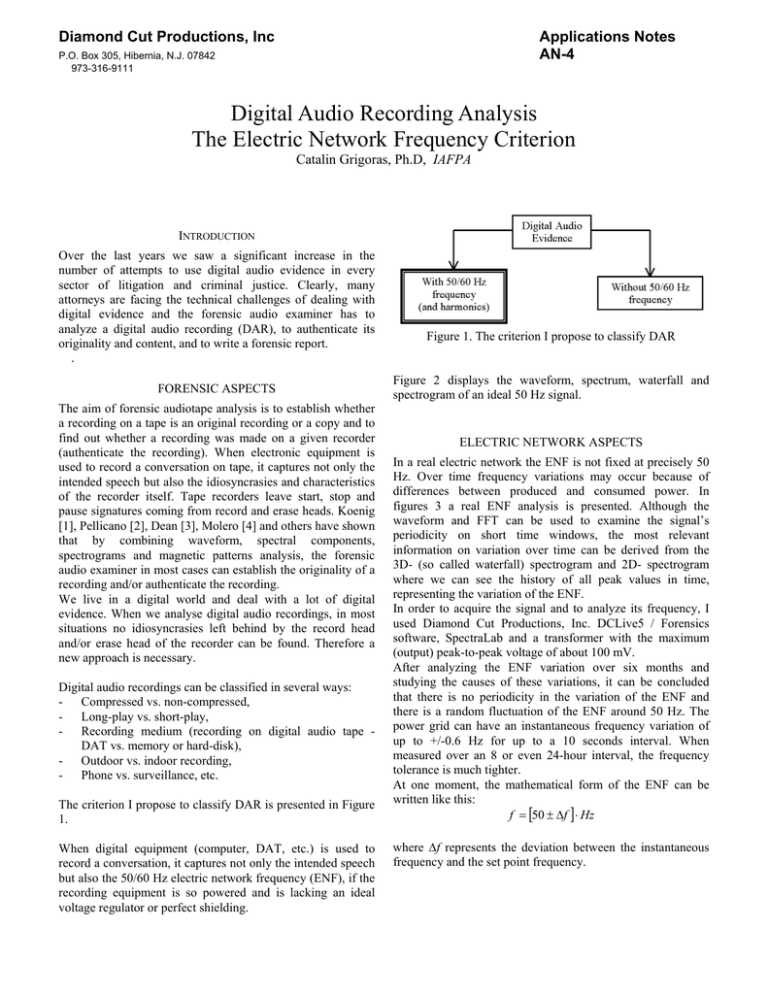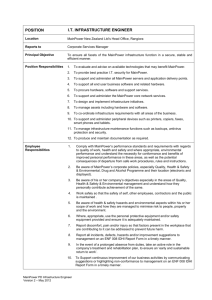Digital Audio Recording Analysis The Electric Network Frequency Criterion Diamond Cut
advertisement

Diamond Cut Productions, Inc Applications Notes AN-4 P.O. Box 305, Hibernia, N.J. 07842 973-316-9111 Digital Audio Recording Analysis The Electric Network Frequency Criterion Catalin Grigoras, Ph.D, IAFPA INTRODUCTION Over the last years we saw a significant increase in the number of attempts to use digital audio evidence in every sector of litigation and criminal justice. Clearly, many attorneys are facing the technical challenges of dealing with digital evidence and the forensic audio examiner has to analyze a digital audio recording (DAR), to authenticate its originality and content, and to write a forensic report. . FORENSIC ASPECTS The aim of forensic audiotape analysis is to establish whether a recording on a tape is an original recording or a copy and to find out whether a recording was made on a given recorder (authenticate the recording). When electronic equipment is used to record a conversation on tape, it captures not only the intended speech but also the idiosyncrasies and characteristics of the recorder itself. Tape recorders leave start, stop and pause signatures coming from record and erase heads. Koenig [1], Pellicano [2], Dean [3], Molero [4] and others have shown that by combining waveform, spectral components, spectrograms and magnetic patterns analysis, the forensic audio examiner in most cases can establish the originality of a recording and/or authenticate the recording. We live in a digital world and deal with a lot of digital evidence. When we analyse digital audio recordings, in most situations no idiosyncrasies left behind by the record head and/or erase head of the recorder can be found. Therefore a new approach is necessary. Digital audio recordings can be classified in several ways: - Compressed vs. non-compressed, - Long-play vs. short-play, - Recording medium (recording on digital audio tape DAT vs. memory or hard-disk), - Outdoor vs. indoor recording, - Phone vs. surveillance, etc. The criterion I propose to classify DAR is presented in Figure 1. When digital equipment (computer, DAT, etc.) is used to record a conversation, it captures not only the intended speech but also the 50/60 Hz electric network frequency (ENF), if the recording equipment is so powered and is lacking an ideal voltage regulator or perfect shielding. Figure 1. The criterion I propose to classify DAR Figure 2 displays the waveform, spectrum, waterfall and spectrogram of an ideal 50 Hz signal. ELECTRIC NETWORK ASPECTS In a real electric network the ENF is not fixed at precisely 50 Hz. Over time frequency variations may occur because of differences between produced and consumed power. In figures 3 a real ENF analysis is presented. Although the waveform and FFT can be used to examine the signal’s periodicity on short time windows, the most relevant information on variation over time can be derived from the 3D- (so called waterfall) spectrogram and 2D- spectrogram where we can see the history of all peak values in time, representing the variation of the ENF. In order to acquire the signal and to analyze its frequency, I used Diamond Cut Productions, Inc. DCLive5 / Forensics software, SpectraLab and a transformer with the maximum (output) peak-to-peak voltage of about 100 mV. After analyzing the ENF variation over six months and studying the causes of these variations, it can be concluded that there is no periodicity in the variation of the ENF and there is a random fluctuation of the ENF around 50 Hz. The power grid can have an instantaneous frequency variation of up to +/-0.6 Hz for up to a 10 seconds interval. When measured over an 8 or even 24-hour interval, the frequency tolerance is much tighter. At one moment, the mathematical form of the ENF can be written like this: f = [50 ± ∆f ] ⋅ Hz where ∆f represents the deviation between the instantaneous frequency and the set point frequency. Diamond Cut Productions, Inc P.O. Box 305, Hibernia, N.J. 07842 973-316-9111 Applications Notes AN-4 (a) Waveform (a) Waveform (b) Spectrum (FFT) (b) Spectrum (FFT) (c) Waterfall (c) Waterfall (d) Spectrogram (d) Spectrogram Figure 2. The waveform (a), spectrum (b), waterfall (c) and spectrogram (d) of an ideal 50 Hz signal Due to the electromagnetic wave propagation, the entire electric network formed by the interconnected systems, including all the sources and loads, will carry the same frequency. Therefore, in an electric network we will find the same frequency through all the loads (houses, offices, labs, Figure 3. The waveform (a), spectrum (b), waterfall (c) and spectrogram (d) of a real 50 Hz signal etc.). From a forensic point of view, frequency is the network’s parameter we are interested to analyze. According to the Union for Power Production and Transport Coordination (UCPTE) recommendation [7], under normal Diamond Cut Productions, Inc P.O. Box 305, Hibernia, N.J. 07842 973-316-9111 conditions the ENF is maintained within strict limits and the set point frequency is around 50 Hz. There are three types of operating conditions, based on ∆f. If ∆f ≤ 50 mHz, the conditions are considered as normal, if 50 mHz < ∆f ≤ 150 mHz operating conditions are deemed to be impaired, but with no major risk, and if ∆f > 150 mHz operating conditions are deemed to be severely impaired and there are significant risks of malfunction of the electric network. From an engineering instrumentation point of view, all electric and electronic systems contain noise sources. To analyze the ENF it is recommended to use only high quality sampling devices with very low levels of noises and distortions. Based on my tests and results, a sound card with a signal to noise ratio less than -94 dB and total harmonic distorsions less than 0.003 % will offer you the possibility to analyse ENF without relevant errors and distorsions. The signal’s downsampling operation is combined with a fftband pass filter with the cut frequencies below 49 Hz and above 51 Hz. This filter eliminates the other signals on 0 – 60 Hz band and does not modify the ENF component which is around 50 Hz. For this purposes you can use the “Change Sample Rate / Resolution” function in DCLive / Forensics. EXPERIMENTS The tests made between summer 1998 – autumn 2000 on different locations of the same electric network (in the lab, the same building, the same town and in three different cities all connected to the same electric network) showed that for all consumers, at any moment in time, the ENF value is the same. In the following figures are presented the most relevant tests, including system configuration and obtained results. An electronic device based on a transformer which outputs a maximum peak-to-peak voltage of 100 mV was connected to a soundcard on a personal computer. In order to record and analyze the audio signal, I used DCLive / Forensics v5.03 software. In figure 4 the configuration for three cities from the same electric network is presented. Figure 4. The configuration for three cities from the same electric network Applications Notes AN-4 The distances between the cities are more than 200 km. In this situation I used three recording systems, the obtained results having a great degree of correlation. An example of the ENF analysis is given in figure 5. Figure 5. Spectrograms comparison Figure 5 shows that at any one moment in time, all the loads of the electric network experience the same ENF. Computer B in figure 4 was used to store the ENF database. The overall shapes of the spectrograms (CJ, IS and B) are very similar. A detailed analysis of the ENF however, in the time and spectral domain, showed small differences. These are generally considered to be caused by random noise and differences between the sampling boards used in the computers. A CASE WORK EXAMPLE In a recent forensic case I was asked to analyze a digital recording brought to the court as evidence, to establish the authenticity of the recording and its originality. The evidence was an audio file on a CD, WAV PCM format, 16 bit, sampled at 8 KHz, containing more than three hours of conversation between two persons (speaker A and B) and it was made using a recording system installed in a room in an office building. I found that the system allows the audio signal to be picked-up from the room with a small electret microphone, amplified and saved in a WAV PCM format (no compression), 16 bit, 8 KHz, on the hard-disk of a notebook. Speaker A, who had previously been recorded by speaker B with this system, claimed that the recording was altered and that the claimed date of recording was not correct; he indicated another date. Information on both dates was given to the investigator. I established the period of time on which to verify the ENF and tested whether there were any differences in the frequency variations between the ENF reference monitoring system (computer B in figure 4) and the frequency variations measured in the company’s building. I asked the electricity company if there was any break in the network over the last couple of months and I checked whether the building used it’s Diamond Cut Productions, Inc Applications Notes AN-4 P.O. Box 305, Hibernia, N.J. 07842 973-316-9111 own private power supply or was connected to the network. I started by comparing the evidence with my ENF database to see if there was any match. twenty deletions of words and expressions. The discontinuities in ENF that I had discovered matched his indications. ENF DATABASE I started to build the ENF database in May 2000 and for recordings made prior to that date I had to ask the Romanian electricity company to provide me with the necessary information. The space necessary to save the ENF reference as WAV PCM, 16 bit, 120 Hz, is presented in tables 1 and 2. Figure 6. Real case analysis – ENF spectrogram claimed by speaker B Figure 7. Real case analysis – Evidence ENF Table 1. HDD Space over maximum one day Hours 1 8 16 24 Seconds 3600 28800 57600 86400 Capacity [MB] 0.843 6.744 13.488 20.232 Table 2. HDD Space over maximum one year Days Seconds Capacity [MB] 1 86400 20.232 7 604800 141.624 31 2678400 627.192 365 31536000 7384.68 In order to save the reference over one month less than 630 MB is needed which can be saved on a CD and for one year this amounts to twelve CDs. It will be the examiner’s choice to save and to configure the entire reference database for fast access. Figure 8. Real case analysis – ENF spectrogram claimed by speaker A I analyzed the audio file by using DCLive / Forensics software, down sampled the evidence to 120 Hz (with “Change Sample Rate / Resolution” function), band-pass filtered the audio with cut frequencies around 49 and 51 Hz (with “Band Pass Filter” having the following settings: Low Freq = 49 Hz, High Freq = 51 Hz, Filter Slope = 24 dB/Octave, Butterworth), computed the spectrogram with a 4096 points FFT, made a vertical zoom around 50 Hz and compared with the ENF database. The resulting 2Dspectrograms are presented in figures 6, 7 and 8. The conclusion is that the evidence had not been recorded on the date claimed by speaker B and there were matches with the date and time claimed by speaker A. I also checked the evidence’s ENF continuity and I discovered more than ten major discontinuities. I asked speaker A to listen to the evidence, to indicate in the transcription where there are any irregularities and to write down what the original wording was. He indicated more than Diamond Cut Productions, Inc Applications Notes AN-4 P.O. Box 305, Hibernia, N.J. 07842 973-316-9111 On analog audio tape recordings, to use the ENF criterion, two problems remain a challenge: - In the frequency domain, the vertical realignment on spectrogram, same as the horizontal compression of the spectrum (compensating speed differences), - The horizontal adjustment in time domain, which means a stretch. I. CONCLUSIONS Figure 9. An automatic system to identify the date and time when a digital recording was created The entire work to verify or identify the real date and time when a DAR was created needs hours of searching and to optimize it I propose an automatic system like the one presented in figure 9. As can be seen in figure 9, the idea in DAR authentication, based on the presented method, is to verify or try to locate the date and time when a DAR recording has been created and to search for modifications and deletions, to identify their length and to approximate how many samples have been deleted and how the audio segments are linked. APPLICABILITY OF THE ENF CRITERION As an example of a DAT-recorder available to the public I analyzed the Sony DAT Walkman TCD-D100 and its recording particularities. I found that if recordings are made with this recorder powered from the electric network (through its own adapter), they will contain traces of the ENF and the methodology to analyze them as described above can be used. On digital evidence, the ENF varies around 50 Hz, but on analog tapes, because of wow and flutter, the mean value may not be around this value. Also if the play speed is faster than the recording speed, all the frequencies will be shifted up, and if played at a slow speed they will be shifted down and the measured ENF will need to be compensated for this shift. The Electric Network Frequency Criterion is a tool that can be used to analyze digital audio recordings, checking their integrity and verifying or identifying the moments in time when a digital recording was created, by using a reference frequency database built in a laboratory or obtained from the electrical network company. Particular attention should be given to the quality of the reference that is critical in allowing an accurate comparison, as well as to the entire methodology of analysis and evaluation of the results. I recommend the use of the ENF-Criterion in conjunction with other techniques and methods (e.g. impulse response of a room [5] and IT investigations) that must be improved and inserted into a standard procedure or guidelines. By using the Electric Network Frequency Criterion to analyze an evidential recording the forensic audio examiner can transform himself into forensic audio “archeologist”, able to dig deep into audio archives for non-audible information. ACKNOWLEDGMENT The author would like to thank Jos Bouten, Netherlands Forensic Institute, Ministry of Justice, for helpful suggestions and comments on the paper. I appreciate the support of Prof. Brandusa Pantelimon, Politehnica University of Bucharest and Prof. Lucian Ionescu, Director of National Institute of Forensic Expertise, Romania. Finally, I would like to recognize the assistance I have received from Olaf Köster, Bundeskriminalamt (BKA); Peter French, JP French Associates; Tom Owen, The New York Institute of Forensic Audio; Agata Trawinska, Institute of Forensic Research in Cracow and Curtis Crowe, Enhanced Audio, Inc. This manuscript could not have been completed without their help. REFERENCES [1] [2] [3] [4] B.E. Koenig, “Authentication of Forensic Audio Recordings”, J. Audio Eng. Soc., Vol. 38, No.1/2, 1990 January-February A.J. Pellicano, “Tape Recordings as Evidence”, California Lawyer, October 1990 D.J. Dean, “The Relevance of Replay Transients in the Forensic Examination of Analogue Magnetic Tape Recordings”, in Publication No.16/1991, Scientific Research and Development Branch, Home Office, British Government, London S. Molero, “Establishment of the Individual Characteristics of Magnetic Recording Systems for Identification Purposes”, Problems of Forensic Sciences, Second EAFS meeting, Volume XLVII, 2001, Cracow Diamond Cut Productions, Inc P.O. Box 305, Hibernia, N.J. 07842 973-316-9111 [5] [6] [7] C. Grigoras, “Forensic Audio System”, IAFP Annual Conference, 2002, Moscow REFERENCES (cont.) C. Grigoras, “Digital Audio Evidence Analysis”, Advanced Topics in Electrical Engineering Symposium, 2002, Bucharest UCPTE, Summary of the current operating principles of the UCPTE, Text approved by the Steering Committee on 28th October 1998 October 17th, 2003 Applications Notes AN-4





